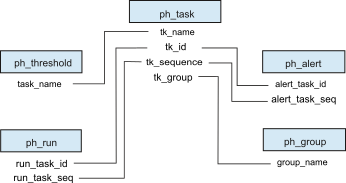The Scheduler tables
The Scheduler stores information about tasks and sensors in five tables in the sysadmin database: ph_task, ph_run, ph_group, ph_alert, and ph_threshold.
The Scheduler is an administrative tool that enables the database server to execute database functions and procedures at predefined times or as determined internally by the server. The five tables used by the Scheduler contain built-in tasks and sensors that run automatically. You can also add your own tasks and sensors by inserting rows into these tables. These tables have relationships between their columns that are described in the following illustration.

For detailed information about using the Scheduler, see the Informix® Administrator's Guide.